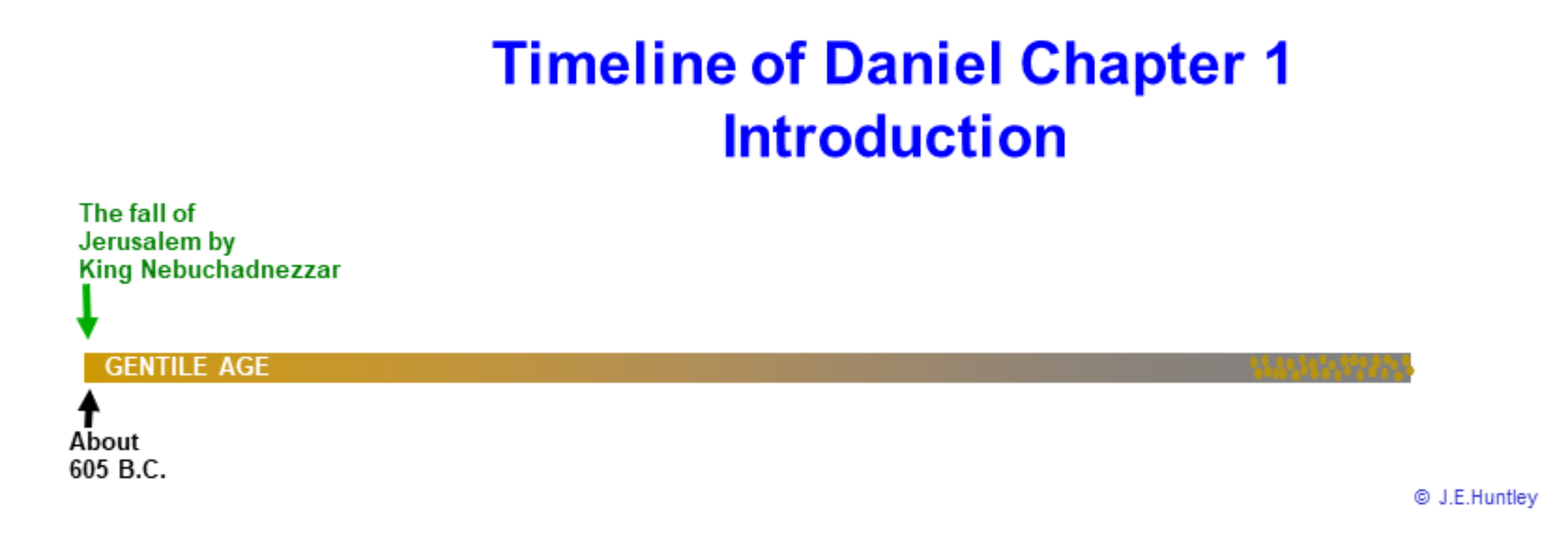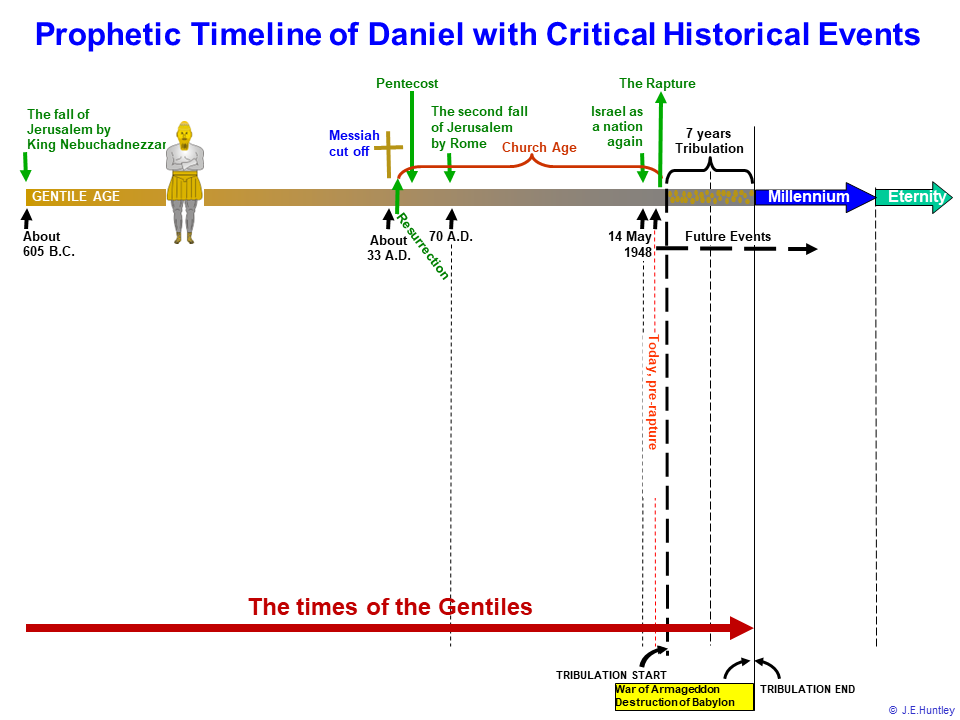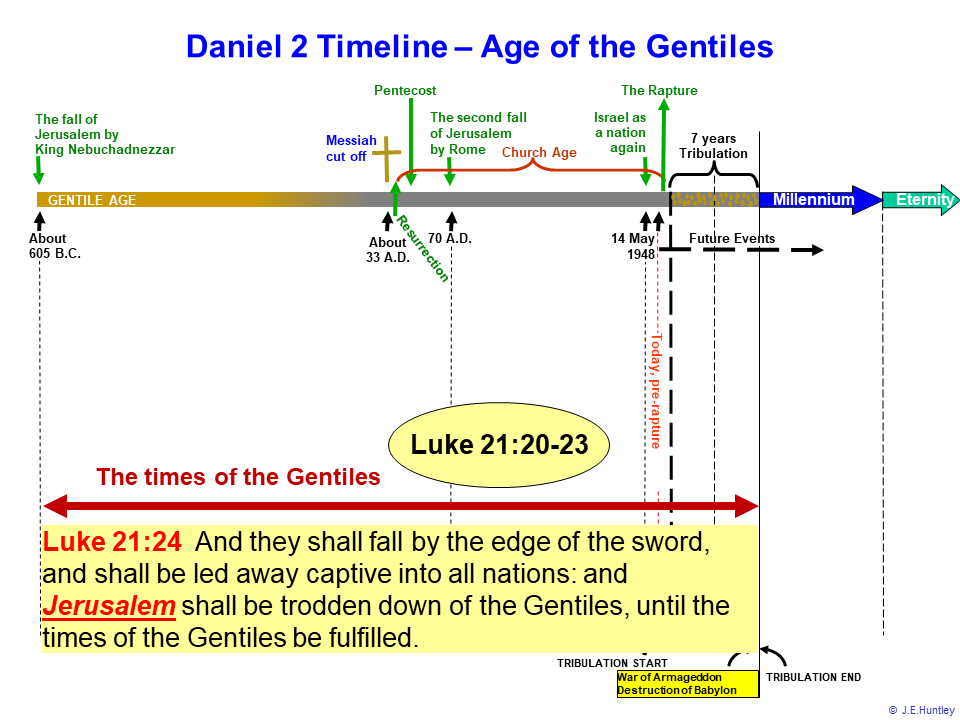Daniel: Introduction to the Base Daniel Timeline
There is much to write concerning the book of Daniel, and many fine books and materials are available that provide in-depth studies on this book. Some of those books are listed in the References section of this website. This site provides a high-level review of this book with numerous and a variety of timelines to aid in understanding what the prophetic passages are, when they could or have occurred in relative terms, and the sequencing of the events. Overall, Daniel is an important key to understand other prophetic passages in scriptures, including the book of Revelation. The books of Daniel and Revelation are intertwined completely. However, more was revealed to Daniel than what he was able to understand in what he recorded, as shown in Daniel 12:8-9. Conversely, the Apostle John, who wrote Revelation, was told to record everything he observed and heard, Revelation 1:11, 19. With respect to Daniel, the Lord may have wanted His people to look forward to the first coming of Jesus, and so the words of Daniel concerning the last days were to be sealed for a later generation, our generation.
It is no coincidence that the beginning of these prophesies of Daniel occurred at the beginning of the days of the Gentiles, when King Nebuchadnezzar was identified as the head of gold in the image he dreamt that represented the Gentile era over Israel, Daniel 2:36-38. Prior to the fall of Judah, the kingdoms of Judah and Israel were ruled by kings, and prior to that, they were led by judges who were raised by the Lord.
Many of the timelines for the book of Daniel cover the period from when the Gentiles began their rule or have significant influence over the affairs of Judah, and specifically Jerusalem and the temple. The timelines for the book of Daniel outline the principal players who will appear during the tribulation period, the length of days, and identifies many issues of importance to all of Israel.
To facilitate the unfolding of prophecies in this book and how they relate to other passages in the Bible, a basic timeline shown below will be used to build representations of the prophecies found in Daniel. Chapter by chapter, each prophetic passage will be added to the base timeline to gradually introduce the complexity of the book of Daniel. The timeline begins when King Nebuchadnezzar began his conquest of Israel, and his eventual destruction of Jerusalem on Babylon’s third invasion. The timeline continues to extend to the right, into the future eternity.
Several of the chapters in Daniel have prophetic passages that will be illustrated on this basic timeline. As each section is examined, appropriate information will be added to the timeline. By the end of Daniel 12, the timeline will have been filled in to present a comprehensive view of what has been presented in the book of Daniel.
Timelines used on this site are intended to aid the reader in understanding the order, extent, and concurrent events that are presented in the many prophetic passages in the Bible. They are general in nature and every effort has been made to assure their accurate depiction of the prophetic passages. However, there are instances where attempting to be precise is unattainable with the tools available. In such instances a generic object, such as a circle or other geometric shape, is used to represent an event to acknowledge the event. This will reduce clutter to the charts, and hopefully provide clarity despite the lack of detail. These limitations are noted as they occur within this site.
Since these are generalized timelines, there is no attempt to maintain equality in the length of time in the occurrence of an event, or between events. Events depicted on the timelines are treated as objects that appear relative in occurrence to one another, but no inference of the elapse of time between events should be made.
In all cases, it is incumbent upon the reader to search the scriptures out for himself or herself, to evaluate the content of this site or any other source against the Word of God. More information on the timelines developed for this site can be found on the interpretations section, following the link to the general survey of timelines used in this website.
As with all timelines, the one used on this website begins with a very simple horizontal bar, as seen in the following graphic. The book of Daniel helps in understanding prophecy in the Bible for several reasons. First, the Lord reveals to Daniel, King Nebuchadnezzar, and to all peoples, His plan for the ages. Beginning with Daniel 1:1-21, Daniel as a teen is carried away with other well-learned and skilled teenage boys and girls, away from Jerusalem to Babylon. After some years of training, the young man Daniel and his fellow Jews, and friends, completed their training and were matriculated within the Babylonian system of advisors to the king. Second, Daniel 2:1-49 provides tremendous revelations concerning four major kingdoms, that began with King Nebuchadnezzar's kingdom. King Nebuchadnezzar was in his third year of his reign at the time of the prophesy revealed to Daniel by the Lord, Daniel 1:5, Daniel 2:1, and the three kingdoms that would follow.

What are the time boundaries for the Gentile age and why are only four kingdoms identified in this prophesy? There were many other great kingdoms in the history of mankind that rivaled Babylon; such as the empires in China, the Mayans, in India, etc.. These and other empires in world history are not considered in Biblical prophecy, or as the start of the Gentile era, since they neither trampled underfoot, nor either controlled or significantly influenced the affairs in Jerusalem. The Gentile era does not even begin at the time when the northern tribes of Israel were taken into captivity by the Assyrians, 2Kings 17:20-24.
What defines the Gentile era is when a Gentile nation has complete and unrestricted rule over the people of Israel AND Jerusalem. Jerusalem is a key in understanding prophecy as brought out in the prophetic timeline revealed to Daniel by the angel Gabriel, Daniel 9:21-25. This is when Gabriel provided details of the 70 prophetic weeks (490 years, see this discussion in this site in Daniel chapter 9). It begins with the order to restore and build Jerusalem, not just the temple. As shown in Daniel 2:36-38, the era of the Gentiles began with the first of three military campaigns by King Nebuchadnezzar against Jerusalem. That period of time will not end until the return of Jesus Christ to establish His millennial kingdom on earth, Revelation 19:11-21, Revelation 20. This was substantiated when the Lord provided the dream of the Gentile era to both King Nebuchadnezzar and Daniel. Therefore, the Gentile rule began when the Jews who populated Judah, after the northern kingdom had been taken captive by the Assyrians, 2Kings 17:1-8, were first displaced from the land the Lord gave them. Gentiles then began their rule over the remnant of Israel, and also began their influence over Jerusalem. This all began with King Nebuchadnezzar (his dream came immediately after the first conquest against Jerusalem). The Gentile rule will not end until the return of the Lord with His saints at the battle of Armageddon, Revelation 19:11-21, to establish the first 1,000 year of His eternal reign over this world.

During the Lord's first earthly ministry, He had said that Jerusalem would continue to be trodden down by the Gentiles until their time was fulfilled, Luke 21:24, which is the end of the seven years of tribulation, the battle known as Armageddon. This is the time of the Lord's return for His second advent, but He will not appear as a humble servant as He did the first time. At His second advent, the Lord Jesus Christ will return as King of kings and Lord of lords, Revelation 19:11-16.
There were other great kingdoms in history; China, Mayan, India, etc., but they do not define the Gentile era. The times of the Gentile era was not initiated when the northern tribes of Israel were conquered by the Assyrians, 2Kings 17:20-24. What defines the Gentile era is the Gentile rule over the people of Israel AND Jerusalem, Daniel 9:24-25.
- The understanding of prophesy is based on Israel and Jerusalem
- The Lord provided the dream of the Gentile era to both King Nebuchadnezzar and Daniel
- The Gentile rule began when the people were first displaced from the land of Judah and Gentiles began their rule/influence over Jerusalem under King Nebuchadnezzar (the dream came immediately after the first conquest against Jerusalem)
- The Gentile rule will end with the return of the Lord with His saints at the battle of Armageddon
- This is not to be confused with the fullness of the Gentiles, when the Lord will return in the clouds to take His church and bride away to be with Him forever more, Romans 11:25, 1Thessalonians 4:13-18
The time of the Gentiles is shown by the solid red ray from left to right between the yellow oval with the scriptural reference to Luke 21:20-23, and the quotation of the scripture that appears in the yellow box. The left end of the ray shows when the times of the Gentiles began, and it will end with the right arrowhead that indicates the fulfillment of the Gentile age.

